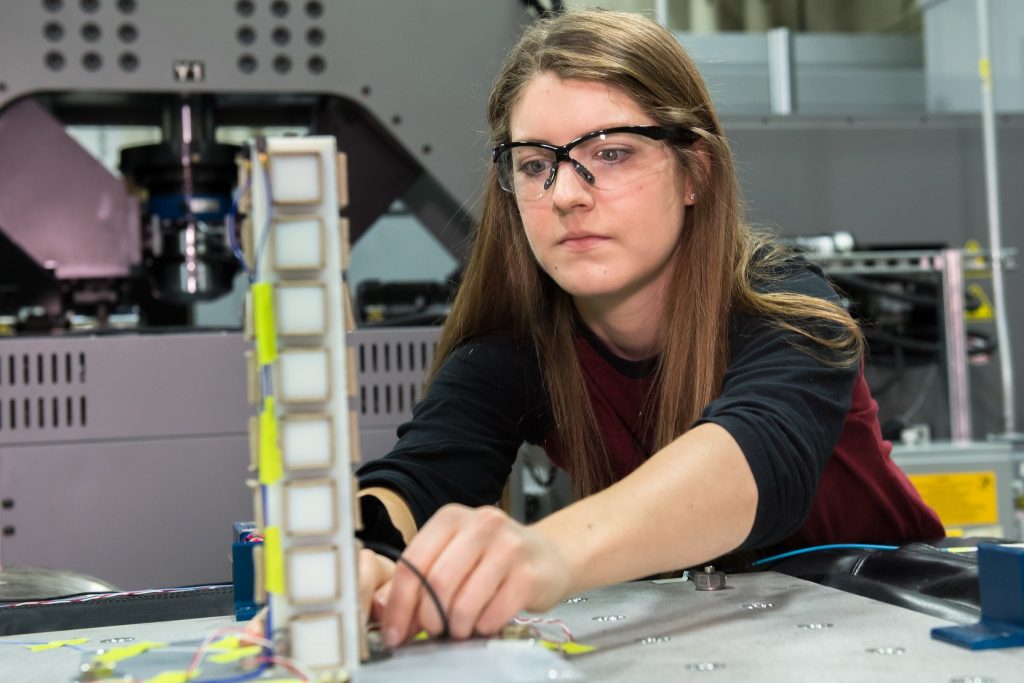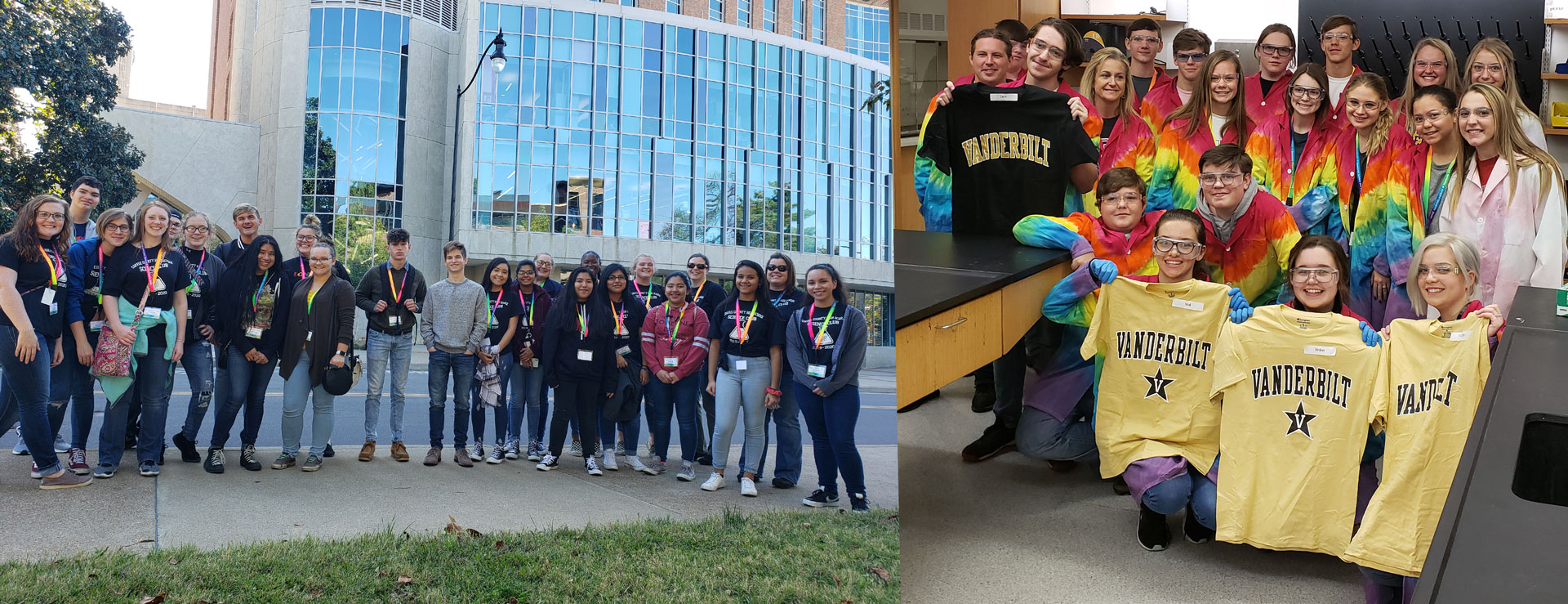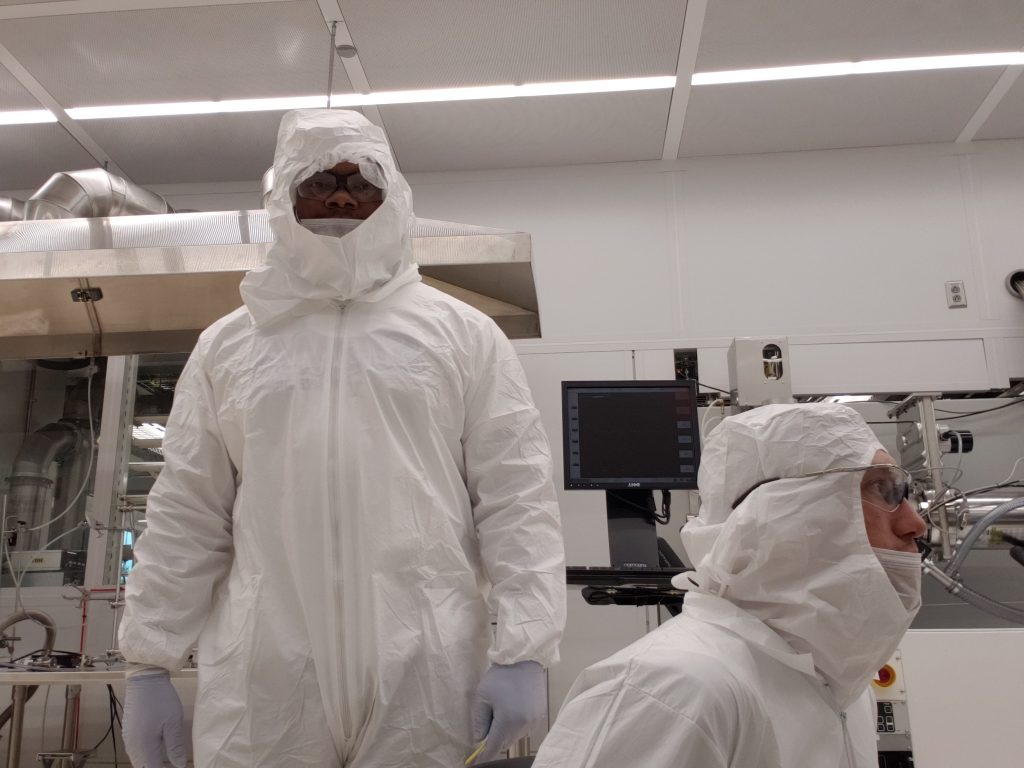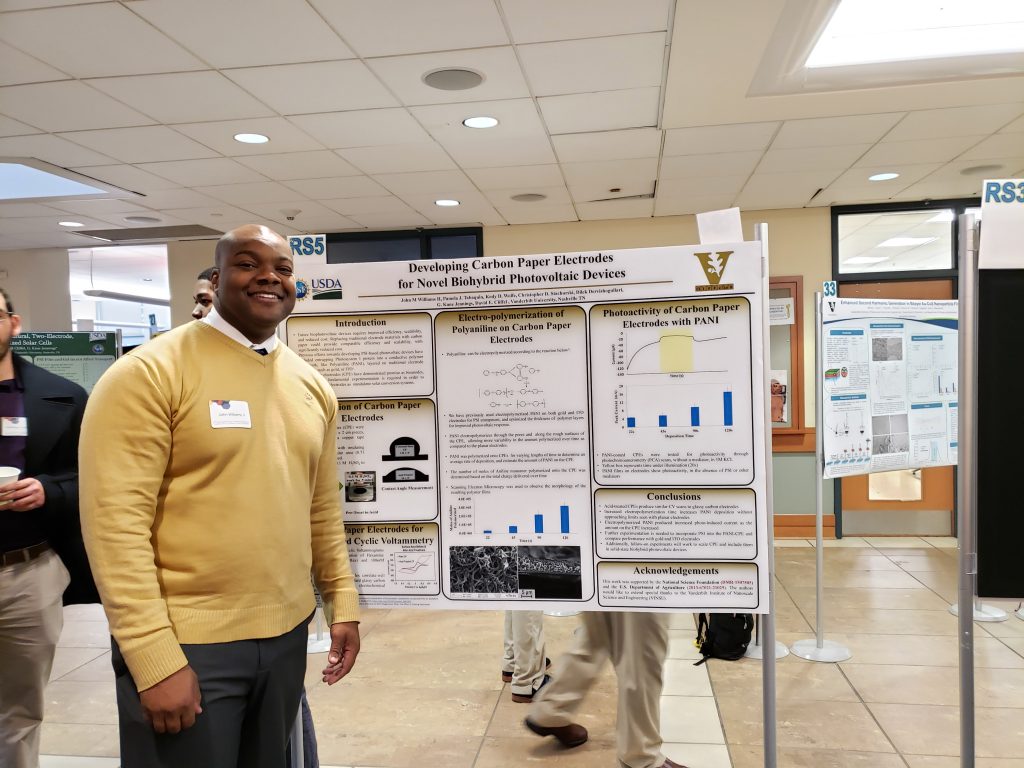
VITAL LINK: Researchers from the U.S. Army Combat Capabilities Development Command Army Research Laboratory and Texas A&M University developed a first-of-its-kind, 3D printable and stimuli-responsive polymeric material expected to open new opportunities for future military platforms. The author notes that officers with doctorates can link these communities and ensure the warfighter is being listened to. (Photo by T’Jae Ellis, Army Research Laboratory)
Developing uniformed strategic technologists: An opportunity in acquisition.
by Maj. John M. Williams II
The Army is piloting a program to help acquisition officers with advanced STEM degrees achieve their Ph.D.s. Recent changes in force structure—combining the requirements, science and technology (S&T) and acquisition communities into cross-functional teams (CFTs)—has highlighted the need for leadership with experience in all three arenas to support the teams’ strategic planning efforts. Through this program, qualified officers can obtain a doctoral degree with three years of Advanced Civil Schooling (ACS). The Army, in turn, has a unique opportunity to shape the acquisition workforce by developing a pipeline of uniformed strategic technologists who can play a significant role in driving modernization.
ALL THE DETAILS
I learned about this program in the summer of 2018 after a call from the acquisition proponent office. I was selected to pilot this new program primarily based on my academic background. I hold a B.S. in chemistry, an M.A. in leadership, and I previously participated in ACS to earn an M.S. in biomedical engineering. There, I conducted advanced research on tissue engineering with human adipose-derived stem cells and biotechnology. Immediately after graduation, I served two years as a faculty member in the chemistry and life sciences department at the United States Military Academy (USMA) at West Point, teaching general chemistry, facilitating a bioengineering course and leading independent research on malaria. After leaving West Point and completing acquisition training, I served as an assistant product manager at the Program Executive Office for Simulation, Training and Instrumentation (PEO STRI) and at the U.S. Army Combat Capabilities and Development Command (DEVCOM) Chemical Biological Center.
After quickly accepting the offer to participate in this program, it was my responsibility to select a school, get accepted into a program and still meet all of the ACS requirements in time to have orders to start school in the fall. I chose Vanderbilt University due to its reputation in research and its location. I chose a Ph.D. in the interdisciplinary material science program because it included an emphasis in the fields of chemistry, mechanical engineering and physics, while allowing me to transfer many of the credits from my previous graduate work.

OTHER AVENUES: University of Michigan doctoral candidate Brittany Essink observes how intricately designed dampeners affect structural design during testing at the CCDC Army Research Laboratory at Aberdeen Proving Ground, Maryland. DOD selects 54 students pursuing doctorate degrees in military relevant research topics to receive a three-year National Defense Science and Engineering Graduate fellowship. (U.S. Army photo)
The application process was somewhat standard, requiring transcripts, purpose statements and academic letters of recommendation, for which I leaned on previous colleagues at USMA and DEVCOM Chemical Biological Center. The biggest break in this process came from supporting my center director on a trip to the area. While accompanying him for official duties, I was able to tour Vanderbilt and other local universities, get briefed on local research efforts being funded by the DOD, and most importantly, meet key faculty members within the material science program. I was accepted into the program, working under a faculty member who had experience with ACS officers and the short timelines imposed by the Army. This would ensure I was in the best position to succeed. In July 2019, roughly nine months after first learning about the program, I arrived at Vanderbilt to get a head start on research before beginning classes.

STUDENT WORKSHOPS: High school students from central Tennessee participate in the Vanderbilt Institute of Nanoscale Science and Engineering STEM outreach workshops, where students built solar cells, and toured Vanderbilt’s campus. (Photo courtesy of Maj. John M Williams II)
A JUGGLING ACT
Since arriving on campus, I have been balancing coursework with research and other ACS requirements, like interacting with the university Reserve Officer Training Corps (ROTC) program. My research is focused on developing novel biohybrid photovoltaic devices for expeditionary energy, and my coursework has included topics like nanoparticles, atomic arrangements and electrochemistry. The program has included colloquiums with leading researchers from around the world speaking on breakthroughs in material science and associated fields. I have also been able to take advantage of the Vanderbilt Institute of Nanoscale Science and Engineering’s (VINSE) state-of-the-art facilities and equipment, learning to fabricate and characterize materials at the nanoscale. While the pace and coursework has been challenging, it was necessary to frontload the requirements to ensure I will graduate by May 2022.
Beyond the academic requirements, I have worked to stay connected with the acquisition community and Army modernization efforts. In April 2019, U.S. Army Futures Command (AFC) signed a formal education partnership agreement with Vanderbilt University to codify the efforts of the university to innovate with Soldiers from nearby 101st Airborne Division. I have been able to provide briefings on AFC, the modernization priorities and the language of large-scale combat operations to university leaders. While these briefs are informal, the aim is to better prepare the staff and faculty to interact with AFC and the units from the 101st. Additionally, I have connected with scientists at the Army Research Laboratory (ARL) whose projects are similar to my research efforts. We plan to have an ARL scientist on my Ph.D. committee in order to codify the relationship between the Army lab and the university research group, as well as to ensure the Army is able to directly benefit from my research while in the program.
Lastly, I have had the opportunity to interact with a number of other officers on campus who are earning their degrees through ACS. While most are post-command captains earning MBAs, I met three field-grade officers working toward doctorates in American politics. These officers are a part of the Army Strategic Planning and Policy Program run at the Command and General Staff College. Their program includes two years of course work at a top university, additional training in strategic studies at Fort Leavenworth, Kansas, and a developmental assignment in a strategic planning position. The program was established by former Army Chief of Staff Gen. Raymond T. Odierno to address a shortage of military officers who could think strategically. These officers are highly competitive and come from all branches of the Army. While the new acquisition officer Ph.D. program has some key differences from the Army Strategic Planning and Policy Program, the vision and outcomes align well with the aims of Dr. Bruce D. Jette, assistant secretary of the Army for acquisition, logistics and technology, specifically for developing future Army acquisition leaders with strategic and technical acumen, credentials and skills.

KEEP IT CLEAN: The author, left, learning to fabricate gold wafers using electron beam deposition tools within the VINSE cleanroom. (Photo courtesy of Maj. John M Williams II)
A ROAD MAP TO SUCCESS
I am confident that pursuing a doctorate through ACS was the right decision for me; I would make the following recommendations from others who are interested:
- Start early. If you are currently in ACS, or have recently completed your master’s degree, start thinking about whether or not you would want the terminal degree. The earlier you plan to incorporate this program into your professional timeline, the less constrained you will be by board dates or other requirements.
- Build your academic network. Reach out to the army S&T community (DEVCOM, U.S. Army Engineer Research and Development Center, DARPA, etc.) and leverage the U.S. Military Academy. This can lead to connections with schools, projects and faculty members to simplify the process of getting into a good school and graduating. The Military Academy sends several active-duty officers to Ph.D. programs every year under similar circumstances. DOD funds a number of faculty research groups, and they are often more open to accepting military officers as researchers. If you already have a master’s, reach out to your old group first. You will need them for letters of recommendation anyway, and usually, they will want you back in their lab.
- Be proactive when reaching out to schools. Try to narrow your school search quickly. Then interact with the program administrators as quickly as possible, as you will need them to meet all of the ACS document requirements. Many of these programs are trying to recruit graduate students, especially those with a security clearance who come with their own funding. Try to attend the recruitment activities if possible. The normal window for acceptance for the fall is usually in late spring, beyond the December ACS application deadline. If you have picked a program and faculty adviser before the selection board, you may be able to submit all the required documents without the official acceptance letter.
- Get your ACS packet ready early. Know all of the requirements from ACS and start gathering them as quickly as possible. Know who you are requesting letters from in advance, have unofficial copies of your transcripts to share for an admissions decision, and get your application in as soon as possible.
- Know your professional timeline. This is a major commitment in time and effort that will change your trajectory as an Army officer. You are responsible to ensure you are in the best position to meet all of your professional timeline requirements. A number of new initiatives may help, but it is ultimately up to you to make these decisions. I recommend having an honest conversation with your supervisor and branch manager to discuss your professional timeline and determine if this opportunity is right for you. It is also important to remember that this opportunity comes with an active-duty service obligation of two years for each year of graduate school.

REACH OUT: The author has connected with scientists at the Army Research Laboratory whose projects are similar to his. (Photo by T’Jae Ellis, Army Research Laboratory)
SUPPLY AND DEMAND
The need for uniformed technologists is not new, nor is the effort to develop these types of officers. Leaders within the Army acquisition community have long wanted to leverage officers with STEM backgrounds to lead more technical programs, with the idea that greater familiarity with the technology could improve decisions about program cost, schedule and performance. Both the Defense Threat Reduction Agency and the Defense Advanced Research Projects Agency (DARPA) leverage advanced researchers with Ph.D.s as project managers within their science and technology organizations. An earlier acquisition branch program to develop officers with doctorate degrees, the Uniformed Scientist and Engineer Program, ended in 2010, due in part to a lack of career progression opportunities for these officers, and the need to focus the workforce on other acquisition priorities.
The acquisition proponent has recognized the need for more officers with STEM degrees and has invested in outreach at both the U.S. Military Academy and at ROTC advance camps to introduce future officers earlier to the acquisition functional area. Additionally, the recently established 75th Innovation Command will leverage reservists with educational or occupational expertise within critical STEM fields to support AFC. The Army Medical Department (AMEDD) uses officers who already hold advanced degrees in STEM fields to lead their acquisition efforts, by cross-training them as acquisition officers with an additional skill identifier. AMEDD officers can compete for centrally selected project manager and product manager positions for both medical and traditional acquisition needs.
My last duty as assistant program manager for science and technology portfolio integration at the DEVCOM Chemical Biological Center allowed me to see firsthand the need for acquisition officers with STEM backgrounds. As one of two military personnel at the center, my primary duties could be reduced to one word: translation. It was my responsibility to translate between our technologists (scientists and engineers), the requirements community we supported, and the program offices where we hoped to transition. This included participating in major tabletop exercises, doctrine reviews, and developing operational scenarios for live test or demonstrations with the technology. This was especially critical in trying to align the efforts of our center with the Army modernization priorities and participating with the different cross-functional teams. While our center focused on chemical and biological defense, understanding the programs and technologies being developed by the cross-functional teams would allow the center to align its research efforts to better meet the survivability requirements for future combat operations. Understanding how to make these connections, though, requires leaders who understand the technology, the program timelines, and the concept of operations. Officers who began their careers in a basic branch, served as an assistant program manager in a PEO, and who have conducted rigorous academic research, have the opportunity to serve as a bridge between these different communities, specifically assisting in communicating the needs of the warfighter, the processes of acquisition, and both the limits and capabilities of new technology.
In addition to roles within DEVCOM and the PEOs, uniformed strategic technologists could serve CFTs by better linking the impacts of separate S&T efforts on the overall mission of the CFTs, which may support difficult decisions like funding cuts, program timelines, and requirements trade-offs, increasing the overall impact of the initial research investments. To reach that level of synergy requires a dedicated effort from those who understand and can communicate the research, the programs, and the concept of operations. Having officers serve as strategic technologist in various roles throughout, AFC can help ensure modernization efforts are rooted in warfighter needs and aligned with the program requirements. Further, they may be able to support the efforts of the Army senior research scientists, the 42 flag-level civilian scientists within DEVCOM who help direct Army research in their specific fields. While these officers would not replace their civilian counterparts, their uniformed status, and recent operational experience, could supplement the efforts of the senior research scientists and extend their reach.

SEE HERE: The author presenting his research at the VINSE Nanoday 2019 poster competition. (Photo courtesy of Maj. John M Williams II)
CONCLUSION
Beyond the individual benefit to the officer, this new program provides other advantages to the Army and its science and technology organizations. The presence of an active-duty officer within a research group at a prestigious academic institution creates a link that can be leveraged for years to come. These informal links bolster the efforts by ARL and AFC to better connect with academia, ensuring the Army can tap into these institutions and resources to tackle future challenges. This effort could also leverage the U.S. Military Academy process of educating officers in technical fields, conducting an operational utilization, then teaching and leading research at the academy. Having previously served as faculty at the academy, I have observed great Army officers translate advanced technical concepts to cadets in terms of impact on the force and seen how those skills can be applied to modernization.
I am confident this opportunity will draw talented officers to make greater commitments to the Acquisition workforce. I am optimistic that continuing to support this opportunity will produce long lasting and valuable outcomes for the Army. It is an opportunity we cannot let pass by.
For more information about the program, contact Maj. Laura Freeland, laurajane.r.freeland.mil@mail.mil at Office of the Director, Acquisition Career Management (DACM).
MAJ. JOHN M. WILLIAMS II is a Ph.D. student in the interdisciplinary material science program at Vanderbilt University. He earned an M.S. in biomedical engineering from University of North Carolina Chapel Hill, an M.A. in leadership from University of Texas El Paso, and a B.S. in chemistry and life science from the U.S. Military Academy. He is certified Level III in program management and Level I in engineering, and is an Army Acquisition Corps member.
Read the full article in the Winter 2021 issue of Army AL&T magazine.
Subscribe to Army AL&T News – the premier online news source for the Army Acquisition Workforce. ![]() Subscribe
Subscribe







